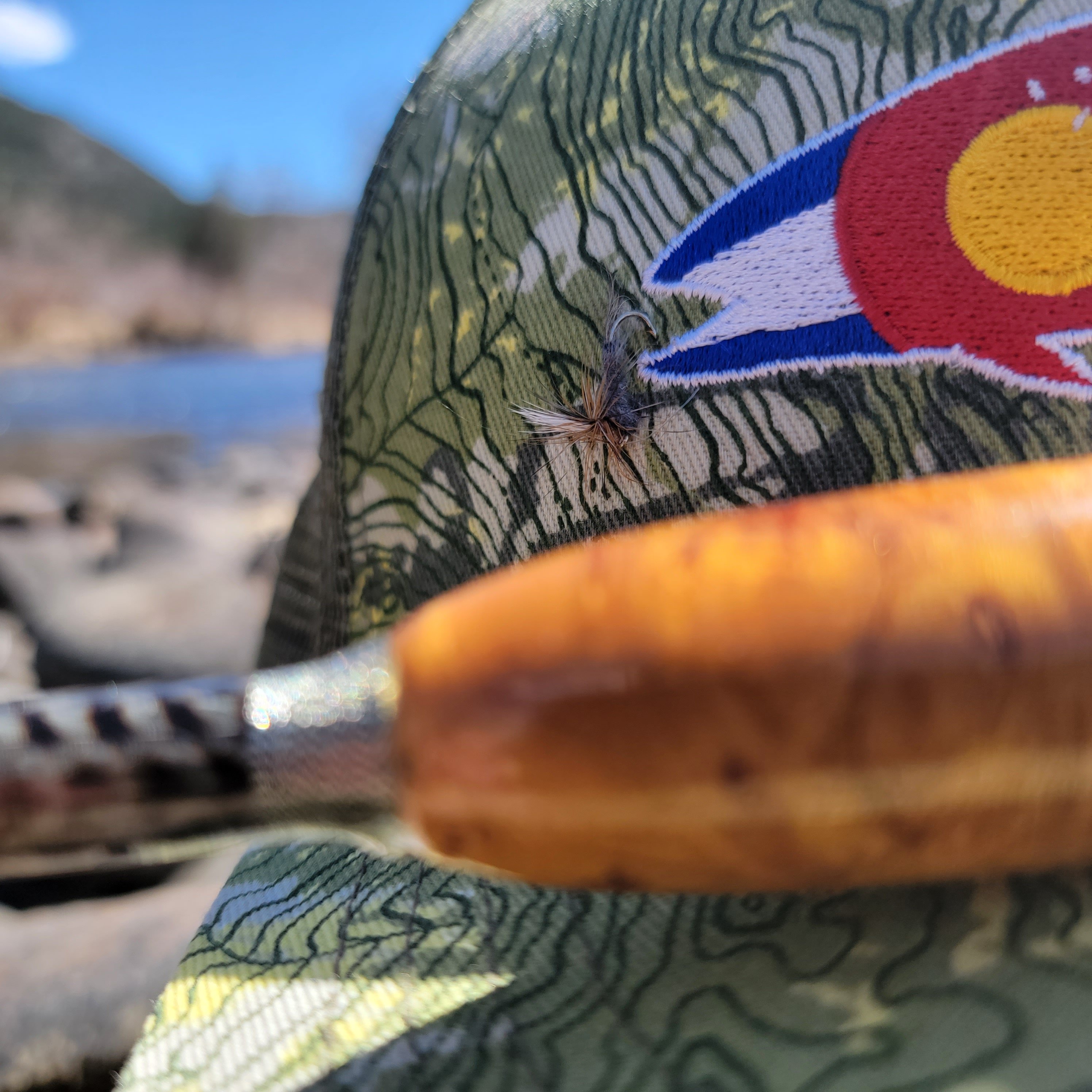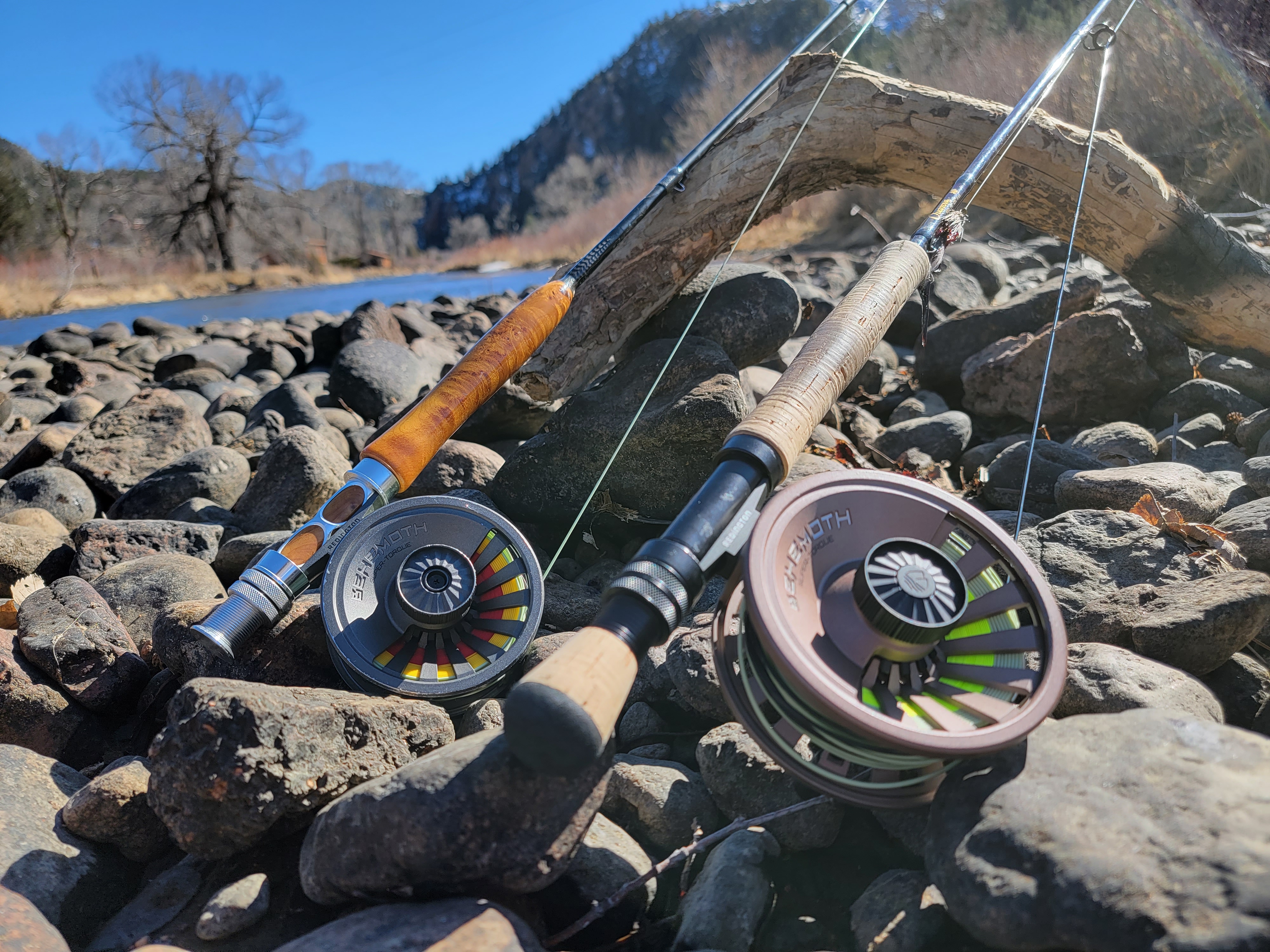.png?width=1920&height=1080&name=Untitled%20design%20(20).png)
Welcome to the fascinating world of fly fishing! Whether you’re a novice angler or brushing up on your fly fishing jargon, understanding the terminology is crucial. Here’s a glossary of essential fly fishing terms to get you started on the right foot.
A-D
Action: Refers to the flexibility of a fly rod. Action can be fast, medium, or slow, indicating how much the rod bends under pressure. Fast action rods are stiffer and bend near the tip, making them ideal for long casts and windy conditions. Slow action rods bend more throughout their length, providing better accuracy and delicacy for short-range casts.
- More info at: https://en.wikipedia.org/wiki/Fishing_rod#Rod_action
Back Cast: The part of the casting process where the rod and line are moved backward, loading the rod for the forward cast. A good back cast is crucial for a successful forward cast, allowing the angler to build momentum. Mastering the back cast helps in achieving greater distance and accuracy.
- More info at: https://en.wikipedia.org/wiki/Fly_casting#Back_cast
Barbless Hook: A hook without a barb, making it easier to release the fish. Barbless hooks minimize injury to the fish, making them a preferred choice for catch-and-release fishing. They also make it easier for anglers to remove the hook from themselves in case of an accidental snag.
Catch and Release: A practice where fish are caught and then returned to the water unharmed. This helps preserve fish populations and ensures sustainable fishing. Proper techniques, such as handling the fish with wet hands and minimizing air exposure, are essential to increase survival rates.
- More info at: https://en.wikipedia.org/wiki/Catch_and_release
Drag: Resistance caused by the current on the fly line or leader. Proper drag adjustment is crucial to avoid breaking the line when a fish strikes. A well-set drag system allows for smooth line release, helping to tire the fish gradually without breaking the line.
For more detailed techniques on catch and release, check out CPW's Catch and Release Tips at cpw.state.co.us/thingstodo/Pages/Fishing.aspx.
E-H
Entomology: The study of insects. In fly fishing, understanding entomology helps anglers select the right fly to match the insects that fish are feeding on. By imitating the natural prey of fish, anglers can increase their chances of success.
- More info at: https://en.wikipedia.org/wiki/Entomology
False Cast: A cast where the line is kept airborne for one or more strokes to extend the length or change direction before the final delivery. It’s a back-and-forth waltz that sets up your final cast. False casting helps in drying off dry flies and adjusting the length of the line for the next cast.
- More info at: https://en.wikipedia.org/wiki/Fly_casting#False_cast
Fly Line: The weighted line used to cast the fly. Fly lines come in various weights, tapers, and colors to suit different fishing conditions. The right fly line can significantly affect casting distance, accuracy, and the presentation of the fly.
- More info at: https://en.wikipedia.org/wiki/Fly_line
Fly Reel: The device attached to the fly rod used to hold the fly line and provide drag. Modern fly reels often come with adjustable drag systems for fighting fish. The reel also serves as a storage system for the fly line and backing.
- More info at: https://en.wikipedia.org/wiki/Fly_reel
Floatant: A chemical applied to dry flies to help them float on the water’s surface. Floatants can come in gel, liquid, or spray forms. They are essential for keeping dry flies buoyant, which is crucial for an effective presentation.
- More info at: https://en.wikipedia.org/wiki/Fishing_fly#Floatant
Learn more about fly line and reels at CPW's Fishing Gear Guidelines at cpw.state.co.us/thingstodo/Pages/Fishing.aspx.
I-L
Indicator: A buoyant object attached to the leader to indicate when a fish strikes. Often used in nymph fishing, indicators help anglers detect subtle bites that might be missed otherwise. They can be made of various materials, including foam, yarn, and plastic.
- More info at: https://en.wikipedia.org/wiki/Strike_indicator
Leader: The length of clear fishing line between the fly line and the fly. Leaders are tapered to provide smooth energy transfer during casting. They come in various lengths and strengths to match different fishing conditions and fly sizes.
- More info at: https://en.wikipedia.org/wiki/Fishing_leader
Line Weight: A classification system for fly lines that indicates their thickness and weight. It ranges from 1 (ultra-light) to 14 (heavy-duty). The appropriate line weight depends on the type of fishing and the size of the flies being used.
- More info at: https://en.wikipedia.org/wiki/Fly_line#Line_weight
Mending: A technique used to reposition the fly line on the water after the cast to achieve a natural drift. Mending helps reduce drag and allows the fly to drift more naturally with the current. It is especially important in nymph fishing and dry fly fishing in moving water.
- More info at: https://en.wikipedia.org/wiki/Mending_(fly_fishing)
M-P
Nymph: A type of fly that imitates the immature stage of an aquatic insect. Nymph fishing is often done below the surface, making it an effective technique for catching fish feeding underwater. Nymphs can imitate various insects, including mayflies, caddisflies, and stoneflies.
- More info at: https://en.wikipedia.org/wiki/Nymph_fly
Presentation: The act of placing the fly on the water in a natural manner. Good presentation involves smooth delivery, ensuring the line, leader, and fly land gently on the water. Effective presentation is key to convincing fish that the fly is a real insect.
- More info at: https://en.wikipedia.org/wiki/Fly_fishing#Presentation
Roll Cast: A casting technique used to cast the line without a backcast, ideal for tight spaces. It’s the flourish at the end of a gymnast’s routine. Roll casting is useful in areas with limited space, such as under trees or along brushy banks.
- More info at: https://en.wikipedia.org/wiki/Fly_casting#Roll_cast
Run: A section of the river with a moderate current, typically deeper than a riffle. Runs often hold fish because they provide a good flow of oxygen and food. They are ideal spots to target when fly fishing.
- More info at: https://en.wikipedia.org/wiki/Run_(fishing)
Learn more about different casting techniques from the U.S. Forest Service Fishing Guidelines at fs.usda.gov/activity/psicc/recreation/fishing.
Q-Z
Strike: When a fish takes the fly. Anglers must quickly set the hook to secure the fish. Recognizing a strike and reacting promptly is crucial for a successful catch.
Tippet: The final segment of the leader, to which the fly is tied. Tippet size is chosen based on the size of the fly and the type of fish being targeted. It is important to match the tippet strength to the conditions and the fish species.
- More info at: https://en.wikipedia.org/wiki/Tippet_(fly_fishing)
Wet Fly: A type of fly designed to sink and be fished below the water’s surface. Wet flies can imitate various aquatic creatures, including insects and small fish. They are effective for attracting fish that feed underwater.
- More info at: https://en.wikipedia.org/wiki/Wet_fly
Waders: Waterproof pants that allow anglers to stand in water without getting wet. Waders come in various styles, including chest-high and waist-high. They are essential for accessing deeper water and staying comfortable in cold conditions.
- More info at: https://en.wikipedia.org/wiki/Waders
For a comprehensive fly fishing experience, consider visiting these reputable guides and shops:
- Colorado Trout Hunters: https://coloradotrouthunters.com
- 5280 Angler: https://5280angler.com
- Royal Gorge Anglers: https://www.royalgorgeanglers.com
- RIGS Fly Shop & Guide Service: https://fishrigs.com
By familiarizing yourself with these terms, you'll be well-equipped to join the ranks of knowledgeable fly anglers. Happy fishing, and remember to always practice sustainable fishing!
For more fishing tips, license information, and local fishing reports, visit:
- Colorado Parks and Wildlife: https://cpw.state.co.us
- U.S. Forest Service: https://fs.usda.gov
.png?width=300&height=100&name=Copy%20of%20Rise%20Beyond%20Logo%2012.31.24%20(300%20x%20100%20px).png)
.png)


